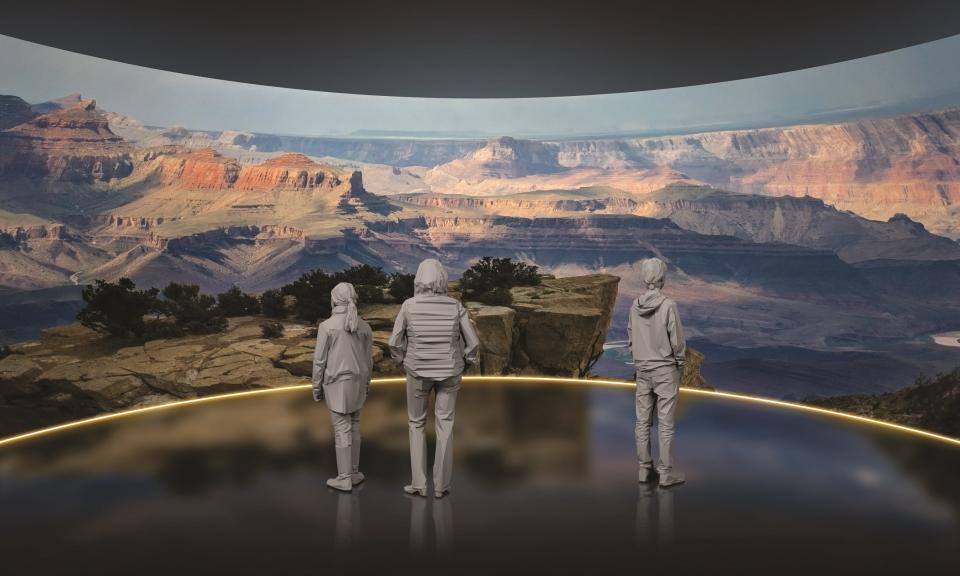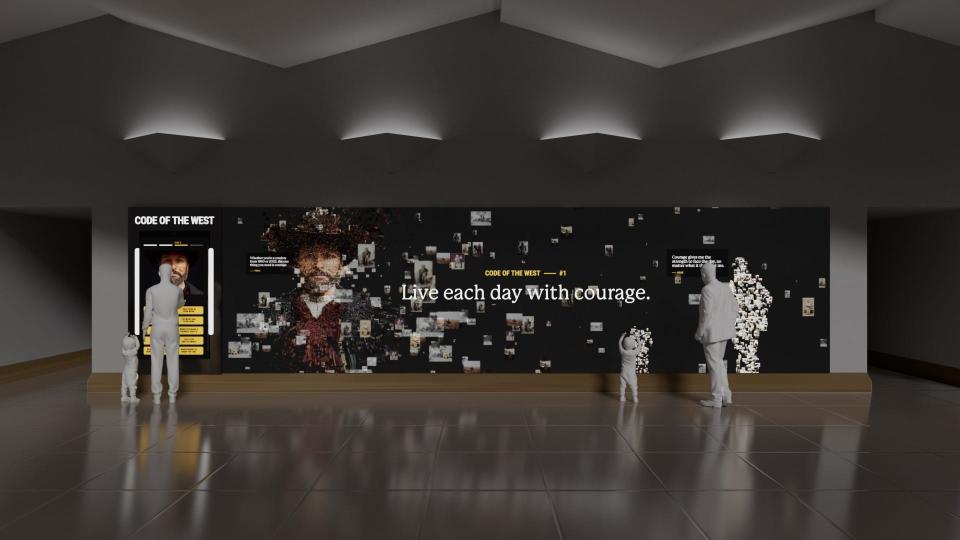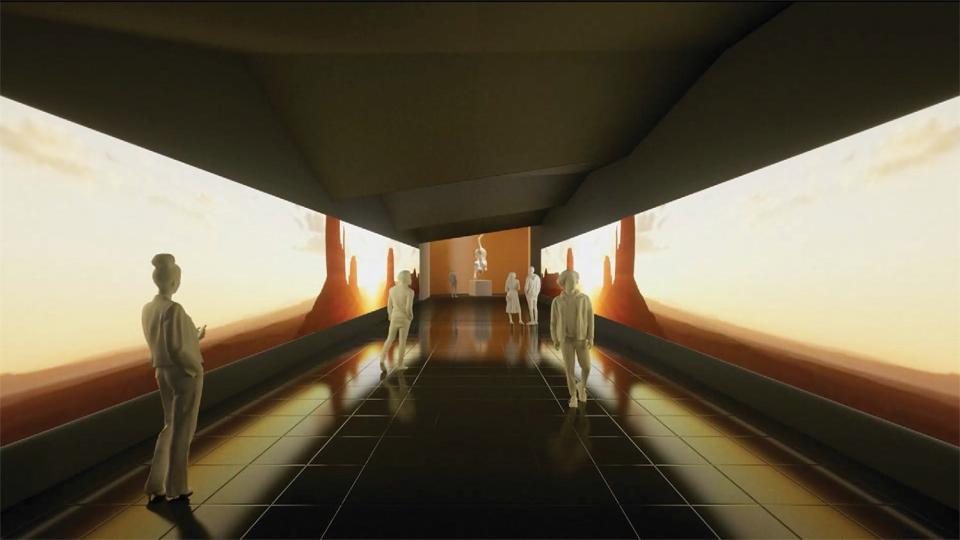OKC's National Cowboy Museum embarks on $40 million capital campaign: What to know
One of Oklahoma City's top attractions is ready to cowboy up with its most comprehensive capital campaign since the 1990s.
Visitors to the National Cowboy & Western Heritage Museum will begin seeing big changes starting this fall as the venerable institution puts the spurs to a $40 million capital campaign.
Construction already has started on "The Code of the West," a new interactive exhibit scheduled to open in November in the museum's East Hallway.
The immersive experience where people can "see themselves through the ethos of the American Cowboy" is the first of many improvements planned under the three-year "Live the Code" campaign devised to modernize, enhance and continue the legacy of the almost 60-year-old institution.
“This is a transformational moment for The Cowboy,” Larry Nichols, the National Cowboy & Western Heritage Museum board member who is chairing the "Live the Code" campaign, said in a statement. “This campaign will strengthen our position as the premier institution of Western history, art and culture while also championing the values so important to the West.”

How much money has the National Cowboy Museum's capital campaign raised so far?
Since the board approved it in April, $7.2 million already has been pledged or awarded through the "Live the Code" campaign, said Seth Spillman, the museum's chief marketing officer. After a "quiet phase" of planning and targeted fundraising, the campaign entered its public phase last week.
The campaign will fund changes ranging from cutting-edge exhibits and parking improvements to upgrades to the museum's storage areas and enhanced accessibility to its vast Dickinson Research Center.
Over the past few years, the National Cowboy Museum has introduced several improvements designed to provide more interactive experiences, modernize its galleries and tell more diverse stories of the West. In 2020, the attraction unveiled both its new $15 million outdoor children's expansion Liichokoshkomo’ and the revamped exhibit space for its permanent collection in the William S. and Ann Atherton Art of the American West Gallery.
"We've been stewards of these materials and these stories since the beginning. But the way that you tell those stories and engage with the audience ... changes over time. We're talking about the first effort like this in the last 30 years, and there are technologies that exist now that didn't exist last year, let alone 30 years ago," Spillman told The Oklahoman.
"Live the Code" is the most comprehensive capital campaign for The Cowboy since 1992's "Visions of the West" $35 million campaign was launched to expand the museum to more than 230,000 square feet and add the Sam Noble Special Events Center, complete with Oklahoma Cultural Treasure Wilson Hurley's five large-scale triptych paintings titled "Windows to the West."

What improvements are planned at the OKC museum, and when will they debut?
After "The Code of the West" interactive exhibit opens this fall in the East Hallway, work is set to begin in early 2024 on "The Immersive Orientation Experience," which will convert the museum's West Hallway into a theater that will give visitors a high-tech preview of what they will see in the galleries.
Work also is scheduled to start in the first quarter on the museum's parking lot, which will be reinforced and repaved to maximize parking options and improve entry into the building. An additional gate will be built to provide parking lot access via Grand Boulevard.
“These visionary enhancements will showcase The Cowboy’s world-class collection while allowing us to tell the stories of the West better than any other institution," museum President and CEO Pat Fitzgerald said in a statement.
Other improvements planned for the three-year campaign:
● The debut of "The Origins of the West 360° Cinematic Experience," a cutting-edge exhibit devised to showcase the diverse landscapes, history and people of the West.
● The expansion of the museum's Art and Artifacts Vault and Dickinson Research Center Vault to include high-density storage to maximize the use of the facilities. The Art and Artifacts Vault will expand into the lower-level staff parking lot as originally designed by the building’s architect, and a new HVAC system and plumbing will ensure proper environmental standards will be maintained to protect the museum’s massive collection.
The Art and Artifacts Vault main storage area houses more than 25,000 items.
"People don't really understand that ... what they see on exhibit throughout the museum, I don't even want to say it's the tip of the iceberg. It's a couple of cubes on the tip of the iceberg of what we have here," Spillman said.
● The move of the Dickinson Research Center from the basement to the ground floor and the addition of an interactive experience to provide researchers and the public greater access to its collection of 3 million items.
The Dickinson Research Center storage space houses 800,000 photographs, 45,000 books, 3,000 audio-visual objects and 800 archival collections.
"The court transcripts that are discussed in 'Killers of the Flower Moon' are in our archives, so we had people involved with the film who were here at the museum doing that research. That's the sort of thing that the public doesn't understand — and why would they?" Spillman said.

Why are the improvements to the National Cowboy Museum important for OKC?
Despite the construction, the museum is maintaining a robust schedule of exhibits and events. Autumn art shows include "American Farmer," a traveling exhibit by celebrated portrait photographer Paul Mobley; "Nations at War! Field Sketches of a Pawnee Warrior," featuring drawings by Brummett Echohawk, a Pawnee soldier who served with the 45th Infantry Division during World War II; and "Black Cowboys: An American Story," which showcases artifacts, photos and documents depicting the work of African American cowboys.
Annual favorites Small Works, Great Wonders and the Traditional Cowboy Arts Association Exhibition & Sale also are still on for fall.
Visit Oklahoma City President Zac Craig said the National Cowboy & Western Heritage Museum has been a "cornerstone of Oklahoma City’s visitor experience" since 1955.
That's the year OKC was selected over Dodge City, Kansas, and Colorado Springs, Colorado, to become the home of what was then called the National Cowboy Hall of Fame and Museum. OKC's central location and proximity to the historic Chisholm Trail gave it an edge over other cities.
A huge fund drive was launched to raise $1 million to buy the land and start building the hall, and the groundbreaking took place on Jan. 7, 1958, with dignitaries from all 17 states represented in the museum attending.
On June 26, 1965, John Wayne led the parade that wound through downtown OKC and out to the museum on Persimmon Hill to mark the grand opening of the National Cowboy Hall of Fame. ("The Duke" was a member of the museum's board of trustees from 1968 until his death in 1979, the same year the John Wayne Collection came to The Cowboy.)
The museum acquired iconic artworks like James Earle Fraser's "End of the Trail," survived the 1980s oil bust and changed its name in 2000 from the National Cowboy Hall of Fame and Western Heritage Center to the current moniker, the National Cowboy & Western Heritage Museum.
"While The Cowboy has drawn scores of national and international visitors to town, they also experience other attractions, stay in our hotels and eat out at our many restaurants while here. The Cowboy has contributed greatly to the growth of OKC’s visitor economy, and these improvements will ensure that The Cowboy continues to be the premier institution for Western art and artifacts," Craig told The Oklahoman in an email.
"OKC’s tourism industry generates $4.3 billion annually, and we expect this economic impact to continue climbing as attractions like The Cowboy elevate and expand their world-class experiences.”
This article originally appeared on Oklahoman: Big changes are planned at OKC's National Cowboy Museum: What to know
